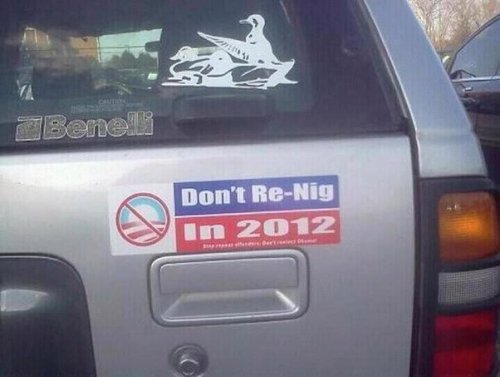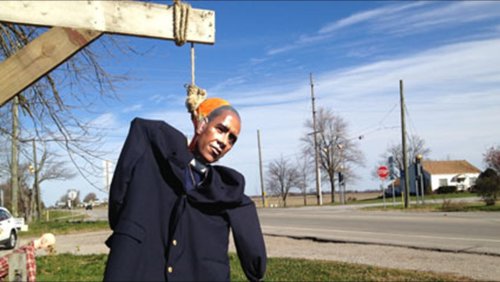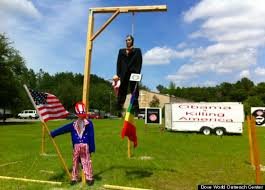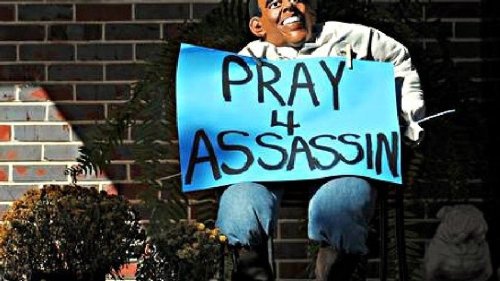
BeaverFever
Senior Member-
Posts
6,088 -
Joined
-
Last visited
-
Days Won
26
Content Type
Profiles
Forums
Events
Everything posted by BeaverFever
-
The Left and Political Violence
BeaverFever replied to West's topic in Federal Politics in the United States
It wasn’t illegal or political violence. Stealing the documents was illegal and the “raid” was a polite and professional search arranged with Trump security in advance with FBI agents discretely wearing civilian clothes so as not disturb the other guests. -
The Left and Political Violence
BeaverFever replied to West's topic in Federal Politics in the United States
Then Tucker realized he had the house key on him the whole time -
Just Losing A Job?
BeaverFever replied to gatomontes99's topic in Federal Politics in the United States
Another opposite-of-reality post by the right. “Punch a Nazi” came about because the Right produced actual Nazis, one of whom killed a woman after ramming a crowd with his car. The claim that anyone to the right of Bernie Sander was labeled a nazi is also a made up lie. Right wingers clearly don’t believe rights are universal which is why the OP wants people jailed for insulting Trump And other influencers are consumed with “retribution” fantasies of rounding up the media, previously called for rounding up Muslims etc. A core principle of conservatism is social hierarchy where people at the top are to a certain degree “above the law” and social norms and people at the bottom are “below the law” and don’t deserve all the basic rights, which must be earned. Just look at their views they’ve regularly expressed about the death penalty, torture, civilian casualties, migrants, and so on -
Vance as a US President
BeaverFever replied to August1991's topic in Federal Politics in the United States
MAGA Enters Racist Meltdown Mode Over J.D. Vance’s Wife The far right is absolutely losing it over Usha Vance. The past week has seen an outpouring of hate from the far right over the wife of Republican vice presidential nominee J.D. Vance. The unremarkable fact that Vance is married to Usha Vance, a woman of Indian heritage, has become a fixation for white nationalists online. Following Monday’s announcement of Vance as Trump’s running mate, white nationalist “groyper” Nick Fuentes seemed to enter a meltdown on his broadcast, saying, “What kind of man marries somebody that isn’t a Christian? What kind of man marries somebody named Usha? Clearly, he doesn’t value his racial identity, his heritage. Clearly, he doesn’t value his religion. He doesn’t marry a woman that professes Jesus Christ? What does that say about him?” Jaden McNeil, another white nationalist activist, posted a picture of Vance, his wife, and their newborn with the caption, “I’m sure this guy is going to be great on immigration.” Other prominent far-right accounts havesimilarly bemoaned Vance’s multiracial family, with replies awash in bigotry. “There is an obvious Indian coup taking place in the US right before our eyes,” whined far-right conspiracy theorist Stew Peters. …. https://newrepublic.com/post/183975/maga-racist-meltdown-jd-vance-wife-usha -
Yeah a Republican gun nut whose phone search history revealed he was researching public appearances of other public figures including Biden, Merrick Garland and members of the British royal family in the days before the murder, in addition to researching his mental health. Sounds like he just wanted to kill a famous or powerful person.
-
It is edgy. The photographer who planned and took the phot is described as some known for edgy photos. If it was Republican standing with an Obama head you would say it’s all in harmless good fun and controversial views shouldn’t be silenced no matter whose feelings get hurt and Dems are just trying to stifle free speech That’s what Republicans have said in the past.
-
So in your world an elected official calling for Obama to be executed is a mild statement but saying Trump should have to pay for his own private security is an undeniable death threat. Seriously. Lol no you wouldn’t. Cable TV and the internet are CRAWLING with right wing trolls and influencers they must outnumber liberals 10:1. And are there any influencers more vile than Alex Jones? Jussie Smollett is not a Democrat influencer he was just an actor seeking attention. When he starts going on tour with AOC and speaking at Democrat rallies give me a call. Also he didn’t call for anyone to be executed he just falsely claimed he was attacked by bigots. Your standard for what constitutes hate speech is ridiculously low when it come to alleged Democrats and ridiculously high when it comes to Republicans. Do you honestly think you apply the same standards across the board?? Sorry YOU’RE the liar. That’s not what was said at all. What was said is that people convicted of a felony shouldn’t be entitled to taxpayer funded Secret Service protection, and that Trump can certainly afford his own private protection. Considering Republicans don’t believe people convicted of felonies should be allowed to vote or own firearms it’s not an unreasonable policy. Honestly you ought to be ashamed of yourself the way you misrepresent things I tell you what silly boy you better support giving me taxpayer funded 24/7 security otherwise I’ll complain that you’re calling for my death. Seriously you should just drop the dumb arguments they’re not helping you. BTW the schoolyard insult I was referring to was the politician who allegedly joked that trump wasn’t human The motion to ban SS protection from convicted felons - which you would totally 100% support if Obama or Biden - were a convicted felon - wasn’t a joke or insult LMAO you’re pathetic. Are trying to claim that calling someone a communist is completely different from calling them a Marxist and somehow my point about his verbal attacks has been disproven? Are you suggesting that if I had said PP’s got a long track record of insulting Liberals by calling them Communists and Marxists you would have wholeheartedly agreed? Are you even claiming there’s a difference? You were proven wrong and a like typical conservative loser you respond to defeat and humiliation by denying reality You’re like Donald Trump correcting that hurricane map with a friggin magic marker because he couldn’t admit he accidentally included a wrong state in a hurricane tweet Or like Donald Trump denying he lost the 2020 election You make us laugh but your ridiculous assertions like this convince nobody No, you were vague and poorly articulated what you meant by “worse”. How can it be the same but also worse? Excessive accusations of lying when clearly that’s not what happened is also a sign of your shitty debating skills. I mean in your earlier post when you incorrectly stated I didn’t provide a single example of a Republican politician making hateful comments when I actually had….were you lying? But you’ve already established that random people commenting on the internet don’t count you only want elected officials. In which case ZERO democrats said “too bad he missed.” If you want to include any random tweeter or YouTube personality the Republicans have LEGIONS of trolls who have been screaming vile things about Obama, Biden, Pelosi, AOC, Schiff, Schumer for years and there is equivalent on the left. Let’s not forget all the right wing hate groups like Patriot Front who police caught mustering in a Uhaul truck in full riot gear about to attack a nearby LGBTQ picnic . A smaller vile crowd also exists on the far right in Canada. No no you want all those excluded because you have one politician who joked trump wasn’t human and some politicians who understandably argue it’s absurd to deny felons the right to vote for the rest of their lives but to pay for their lifelong 24/7 security….which you think is worse than calling for Obama and others to be executed
-
So multiple instances of lynching Obama in effigy is ok but beheading a Trump doll as party of an “edgy” photoshoot is not ok? Remember when Republicans are burning Korans and drawing cartoons of Mohammad freedom of expression was supposedly sacred? I don’t at all find it a coincidence that the only things you consider offensive id anything that that conflict with your political affiliation Siggh…live in reality much? that wasn’t his ACTUAL Halloween costume and multimillionaire Trump Jr isn’t trying to save money on a clever costume either. Since you are clearly clueless, it was 80+ yr old Pelosi who got his skulls fractured in a hammer attack by a deranged man, which Jr and his ghouls were making fun of. As it was late at night Pelosi was wearing a pyjama shirt and boxer shorts. Republicans spread the lie that both men were shirtless and in tighty-whities to suggest something sexually inappropriate was going on between them and defuse any sympathy for the victim. Therefore Don Jr’s tweet was to ridicule a brutal on an elderly senior citizen and to spread viscous lies about the victim. Period
-
No I posted many examples of actual Republican elected officials, as well as outspoken Republican influencers. You gave a few examples of Democrats making schoolyard insults. and some were not even that. Honestly you think suggesting Trump should pay for his own security is worse than calling for Obama and Biden to be executed? Not only are you guilty of self-serving memory and selective awareness, your self-serving selective judgment is on display yet again. OMG you are so desperate to back up your ridiculous bullshit claim even you must’ve had a hard time keeping a straight face pretending this is the same thing as calling for his death, The proposed act would have cancelled SECRET SERVICE for any protected person convicted of a felony, BTW, not just Trump. To say that is the exact same as calling for Trump’s death especially for someone as rich as trump with his own private security and compounds, is beyond absurd. What you think it was a typo? He said that and similar things repeatedly. If it’s such unfortunate speech that gets people killed as you claim, he wouldn’t have been made VP just with an “oops sorry”. LOL sure, pal, sure. Your examples are pathetic. Nearly all Republican speeches are nothing more than rants about Democrats destroying America, they are nothing without the evil democrats to rage and rant against they have nothing of their own, everything they talk about relates to stopping democrats and the left. The Oklahoma official mandating bible lessons in public school couldn’t even explain the reason for the policy to reporters other than repeatedly suggesting anyone who would question it is a “leftist extremist” As for 2 decades, It’s hard to draw a line, Rush Limbaugh had been around a long time, his bombast used to be on the fringe now it’s mainstream. And then there’s Bill O’Reilly, Sean Hannity, Tucker Carlson, and more who have made bombast and outrageous accusations part of their normal daily fare dating back to Clinton years and before. We could go back further to the John Birch Society, William F Buckley and McCarthyism. Where do you draw the line? You can start with them or the post-9/11 Republican hysteria when all Democrats were called terrorist lovers for questioning the Patriot Act and Bush’s fabricated lies justifying the invasion of Iraq, Obama was accused of being a secret Islamist raised in a Madrassa, or the Tea Party Movement and all the racist anti- Obama rhetoric that came out, or the MAGA movement. The Republican hate machine didn’t appear out of thin air it moved from the party’s fringe to the mainstream. Which is it, Dems do similar things or worse things? If by “worse” you actually meant “more frequent” you’re still wrong and you have failed to provide either more examples or more extreme examples. No you just make up bullshit claims then accuse anyone who disagrees with you is a liar. For example when I once pointed put that PP has a long track record of calling Liberals Marxists and posted the clips to prove it, you tried to call me a liar because in some of the clips he said “communists” not Marxists as if that’s a difference. As far as lying goes: You also make up a lot of BS like “the left” supported Hitler when it fact “the left” was some if the most vocal opponents and the Hitler admirers were all on the right. And the. After I buried you in evidence to the contrary You tried to walk that back to “well someone [unnamed] on the left ‘ballyhooed’ his economic reforms” and again offered zero evidence. In short, when you’re cornered you resort to absolute bullshit like your post above claiming that calling for Secret Service protection to removed from convicted felons is the same as calling for their murder. MTG is a non-Republican now? Trump Jr is a non-Republican? I posted plenty of evidence of Republicans, some elected officials and some prominent influencers. You posted nonsense. Sorry your posts were garbage and that is why YOU are ramping up the insults and “overheated rhetoric” against me, something you do often whenever you get busted with dubious arguments and shown irrefutable evidence. TBH, I don’t think you and some others on here are primarily liars. I mean you’ll bullshit when absolutely necessary but mostly you’re just blind to how much your emotions control your perception of reality. Emotions have always played a larger role in Conservatism than in other parties: Fawning adoration of the leader unlike anything ever seen in the left even for left wing celebrities like Bill Clinton, Obama and the Trudeaus. Also burning hatred for the other party and despised social groups (immigrants, LGBTQ, etc.). So as a result when a Republican does something absolutely despicable you don’t have a negative emotional reaction to it (you might even like it, such as Trump Jrs tweets I mentioned) but if a Democrat does something even minor like use the word “deplorable” you have a strong negative emotional reaction as if it was the most unspeakable thing ever. You’re hardwired to minimize, ignore and forget the transgressions of your party while grossly exaggerate and overreact to those of the other party or groups you hate. But that’s what Trumpism is all about, the GOP is now the “choose your own reality” party. Go from one Trump supporter to the next they all have different versions of reality even from each other, other than they all worship the same messiah no matter what universe they live in. So it’s not at all surprising that you live in a reality where you thinkRepublicans rarely use “overheated rhetoric” but the occasional mild chiding and standard criticism by Democrats is frequent and outrageous attacks.
-
I have long thought that it’s time for the Snowbirds to go. We can’t spare the resources for a flight demo team when there’s a critical shortage of pilots and maintenance personnel and damn well everything else. Watching 60-yr old subsonic training aircraft isn’t all that exciting anyway, I find them kind of boring compared to Blue Angels or Thunderbirds in their F/A-18s and F-16s. They should have been cancelled long ago but the government kept them active to avoid controversy from the very same Canadian public who has been generally uninterested in military spending. Keeping the snowbirds this long was about maintaining outward appearances while gutting the CAF so axing the snowbirds would be an overdue wakeup call for the public. As for the MCDVs, don’t get me started on those detestable pieces of crap that have been crap since they were first purchased. Feels like we would need something to replace them but we probably can’t spare the crews in the near future and our procurement is already overwhelmed and FUBAR’d to the extreme especially shipbuilding. I don’t know how we could possibly add this to the list in the foreseeable future.
-
Ottawa looking at retiring some older military equipment — including the Snowbird jets Defence Minister Bill Blair insists no decisions have been made Murray Brewster · CBC News · Posted: Jul 17, 2024 3:00 PM EDT | Last Updated: July 17 The Canadian Air Force Snowbirds fly over Great Falls, Mont., on Friday, June 1, 2007. (Rion Sanders/Associated Press) The Department of National Defence is actively considering whether to retire some older ships, planes and other items of equipment that have become difficult and costly to maintain — including the aircraft belonging to the iconic Snowbird demonstration squadron. In an interview with CBC News, Defence Minister Bill Blair insisted no decisions have been made and he's waiting on advice from military leaders. Blair said the 1960s-vintage CT-114 Tutor jets used by the Snowbirds have been in service too long. He said he's asked the commander of the air force whether the planes — which were given a life extension to 2025 and are now going through an additional upgrade — have finally "aged out." Defence Minister Bill Blair: 'I want to maintain the Snowbirds. I just want to get them a better plane.' (Sean Kilpatrick/The Canadian Press) "The reality is the Tutor plane is well past its utility," Blair said. "There are even some safety issues that are deeply concerning to me and I've received assurances that through this flight season ... they can manage those safely, but it continues to persist as a concern." Blair did not elaborate on those safety issues. The aircraft have crashed a number of times. Capt. Jennifer Casey, an air force public affairs officer, died on May 17, 2020 when the Snowbird she was in crashed after takeoff near Kamloops, B.C. Gov. Gen. Julie Payette, followed by Defence Minister Harjit Sajjan, attends the homecoming ceremony for RCAF Capt. Jennifer Casey at Halifax Stanfield International Airport in Enfield, N.S. on Sunday, May 24, 2020. Casey, a military public affairs officer and a Halifax native, was killed in the crash of a Snowbirds Tutor jet in a residential area of Kamloops, B.C.(Andrew Vaughan/The Canadian Press) The air force recently installed new avionics the defence department says can keep the demonstration jets flying until perhaps 2030 — almost 70 years after they were purchased. Defence sources say the navy's 1990s vintage minesweepers, known as maritime coastal defence vessels (MCDVs), could also be on the chopping block. "There's a number of our ships that have ... they're becoming increasingly expensive, almost prohibitively expensive to maintain and ... even to staff," Blair said, adding he's awaiting a recommendation from the commander of the navy. Chief of the Defence Staff Gen. Wayne Eyre talks to his troops at Garrison Petawawa in Petawawa, Ont. on Thursday, Oct. 19, 2023. (Sean Kilpatrick/The Canadian Press) The country's soon-to-retire top military commander, Gen. Wayne Eyre, said the Canadian Armed Forces (CAF) is examining a list of older capabilities that should be replaced, the time it might take to replace them and whether it makes sense to take that equipment out of service in the meantime. Eyre would not discuss details, saying the decision ultimately will be up to the minister and his successor, Lt.-Gen. (soon to be General) Jennie Carignan. The navy has made a case publicly for replacing its four Victoria-class submarines and the Liberal government announced during the recent NATO Summit in Washington that it would proceed with the program. The defence department was asked a series of questions about ships, planes and other pieces of equipment that are near the end of their service lives. It did not respond. Eyre said the tough choices are not so much about budgets as they are about the age and survivability of the equipment. "As a capability ages out, there's a declining pool of spare parts to be able to keep it going," he said. "Opening up assembly lines for some of these spare parts — if they're very small, if it's a fleet that is very small worldwide — may not make a lot of sense." The naval tugboat Glenivis assists as HMCS St. John's heads to the Mediterranean in Halifax on Monday, Jan. 9, 2017. The recent budget set aside money to maintain Halifax-class frigates like the St. John's. (Andrew Vaughan/Canadian Press) The recent federal budget set aside funding to maintain older warships, such as the navy's Halifax-class frigates. But Eyre said not all of the military's needs were covered and "there's a delta" between the upkeep required and the amount of cash available. The aging-out crisis now gripping the military has been decades in the making and is the product of successive governments "not wanting to make the hard choices," said Christian Leuprecht, a professor at the Royal Military College of Canada. He said the military and the government will have to take care in choosing which items of equipment to decommission and when. "Our allies are seeing that Canada is effectively reducing capabilities because it simply doesn't have the money, the political will or the human resources to generate new capabilities — or to even sustain the capabilities Canada currently has," said Leuprecht. He added he believes the staffing crisis within the military is making the situation worse by leaving the CAF with fewer technicians to keep older aircraft and ships running. There may be no better example of the federal government's reluctance to replace military equipment on a timely basis than the Snowbirds' Tutor jets, which were first ordered by the military in 1961. Maj. Robert Mitchell, right, lead pilot of the Canadian Forces Snowbirds, and Sgt. Marlene Shillingford, crew chief, perform a preflight inspection on their jet before takeoff from Great Falls International Airport on June 1, 2007 in Great Falls, Mont.(Rion Sanders/Associated Press) The jets began their demonstration career in 1967. They adopted the name Snowbirds in 1971 and were formally designated as the airshow team in 1975. The Tutors also served for decades as the air force's principal jet trainer before being retired from that task in the early 2000s. Of the 191 originally ordered, roughly 26 are thought to be in the air force inventory or in storage. In 2003, the air force was urged in no uncertain terms to quickly replace the Tutors, which were considered well-maintained but ancient. A study by the defence department's director of major service delivery procurement warned at the time that the aircraft's life expectancy would run to 2010 but could be extended for another decade if absolutely necessary. Keeping the Tutor poses 'significant' risks, report warned "With each passing year, the technical, safety and financial risk associated with extending the Tutor into its fifth decade and beyond will escalate," said the review, written in August 2003. "These risks are significant, however they are not easily quantified." The Snowbirds kept flying, however. A DND report from the fall of 2014 cleared the fleet as "technically airworthy" but noted "significant concerns, including some caused by financial restraints." That same evaluation said the Tutors could have their lives extended to 2025. "I want to maintain the Snowbirds. I just want to get them a better plane," said Blair, adding that he's asked the commander of the air force about the feasibility of using "existing fighter jets" to maintain an aerial demonstration team, as other allies do. "I think that's something that I want to explore." If Canada's NORAD and NATO commitments make that option impossible, he said, he wants to begin the search for a replacement for the Tutor as soon as possible. https://www.cbc.ca/news/politics/snowbirds-tutor-jets-canadian-armed-forces-1.7266310
-
….not to mention GPS jamming and spoofing is now a common practice in Ukraine and other conflicts which means the ability to operate in “GPS Denied” environment is now a critical core skill that all personnel need to have.
-
No its not and I just provided ample evidence of Republicans saying that far more often about Obama. What “actual democrats” have called for Trump to be killed? You’re using a double standard where random people postinghate speech on the internet are counted as speaking for all democrats but not for all republicans So did Trump’s VP pick Vance who called Trump “America’s Hitler”. I can’t believe you’re able to sit there with a straight face and claim Republicans haven’t said similar things about Obama and Biden. Bombastic rhetoric like that has been part of the right’s regular daily rhetoric for a generation going back to Rush Limbaugh. And the comparisons to early Hitler are apt. Remember Hitler originally campaigned in a democratic election and wasn’t killing millions of people at that time. He was a right wing populist scapegoating immigrants attacking the media, using rhetoric similar to Trump’s, promising massive reform and harsh punishment for his opponents with a mob of nationalist supporters committing acts of political violence not unlike J6. When campaigning for election Hitler never told the public he would be a dictator… Trump promised he’d be a dictator on day one. No the reality is that when Republicans say similar or worse things you either ignored it or delete it from your memory because it’s not useful information for you. Or you justify it as harmless or accurate. When Teump recently retweeted a post showing Biden tied up and abducted in the back of a truck I don’t recall you being offended. How many democrats have said Trump should be killed? And remember if all the random people on the internet spewing right wing hate speech don’t count if they’re not actual republican politicians them then they don’t count if they’ve not actual democrat politicians. Look at right wing kooks like MTG, Boebert, Tulsi , Gaetz and more who make crossing lines of civility their brand. Nobody ever booed or heckled the President during their State of the Union Speech until Republicans started doing it to Obama which escalated to characters like MTG and Boebert literally jumping out of their seats and screaming insults at Biden while he speaks LMAO that’s nothing compared to what Republicans have said daily about democrats for the past decade or 2 I mean at the RNC meeting where Republicans PRETENDED to suddenly care about unity Johnson still said Democrats are “a clear and present danger to America, to our institutions, our values, and our people.” I guess you believed his hilarious excuse that he only said that due to a teleprompter malfunction. But that is routine everyday republican speech and always has been. Obama and Biden were regularly called a dictator amd accused of “destroying America” by Republicans Right-wing host calls for military to execute Obama if Trump is indicted https://www.salon.com/2023/03/20/right-wing-host-calls-for-military-to-execute-obama-if-is-indicted/ GOP Town Hall Derailed by Calls to Execute Obama https://www.thedailybeast.com/cheats/2014/02/07/gop-town-hall-derailed-by-calls-to-execute-obama Donald Trump’s Longtime Butler Called for President Obama to Be Killed https://time.com/4328302/donald-trump-butler-historian-president-obama/ Marjorie Taylor Greene indicated support for executing prominent Democrats in 2018 and 2019 before running for Congress https://amp.cnn.com/cnn/2021/01/26/politics/marjorie-taylor-greene-democrats-violence GOP Fla. House Candidate Calls For Obama To Be Hanged https://www.cbsnews.com/amp/miami/news/gop-fla-house-candidate-calls-for-obama-to-be-hanged/ ‘Dukes of Hazzard’ star John Schneider calls for Joe Biden to be ‘publicly hung’ https://globalnews.ca/news/10186987/dukes-of-hazzard-john-schneider-joe-biden-execution-hung/amp/ DCF Guns owner calls for the killing of President Biden Joe Oltmann, a prominent far-right voice in Colorado politics, says Biden should be tried and executed. https://www.9news.com/article/news/local/next/next-with-kyle-clark/dcf-guns-owner-calls-for-killing-of-president-biden/73-4b636e16-5975-412c-aab3-34a85d580497 Conspiracy Theory Kingpin Calls for Hunter Biden’s Execution At a wild pitstop of the ReAwaken America tour, headlined by Donald Trump Jr., Stew Peters demanded “permanent accountability” for another presidential failson Conspiracy theorist Stew Peters made a startling demand for public executions at the latest stop on the ReAwaken America tour — calling for the death of Joe Biden’s son Hunter as well as Dr. Anthony Fauci, whom Peters insisted should “hang from a length of thick rope until he is dead.” https://www.rollingstone.com/politics/politics-features/conspiracy-theory-stew-peters-hunter-biden-execution-1234816880/ Honestly I could do this all day there are far too many internet search hits to list them all
-
Canada set to be fastest growing economy in G7 in 2025, IMF forecasts Latest outlook puts this country ahead of United States and United Kingdom Published Jul 17, 2024 • Last updated 15 hours ago • 3 minute read The International Monetary Fund is upgrading its forecast for the Canadian economy, projecting it will now grow by 1.3 per cent this year and by 2.4 per cent in 2025, according to a report released Wednesday. In both readings, the forecasts were increased by one-tenth of a percentage point from the IMF’s initial world economic outlook released in April. For 2025, Canada is projected to be the fastest growing economy among the G7 and other advanced economies. The U.S. economy will rank second at 1.9 per cent and the U.K. third at 1.5 per cent growth next year. The projection for global growth remains the same at 3.2 per cent this year, and slightly higher for next year at 3.3 per cent, revised up from 3.2 per cent growth projected in April. https://financialpost.com/news/imf-forecasts-canada-fastest-growing-economy-g7-2025 Clearly, Trudeau is to blame. Right?
-
Don’t be silly I never said that’s the sam thing as saying someone should be killed. We’re talking about the vulgarity and hateful rhetoric that has caused Americans to inch up to where they are today. it’s absolute absurdity to say the democrats are far worse or that there are examples of Dems for every Republican. What a joke! The right wing populists have made vulgarity and rhetoric their brand, on both sides of the border. As I mentioned Trump supporters no-stop used of Nword and C-word in reference to Obama and Hillary, depicting Obama as a monkey, lynching him in effigy, pelting Trudeau with gravel, chasing politicians amd their families down the street, spray painting the C word on their offices, false accusations pedophile (conspiracies while many Republicans are arrested for pedophilia and sex offenses no less) and doing all this in front of their own small children and proudly posting videos of themselves doing it on social media. How many “F-ck Poillievre” bumper stickers are there? Death threats, outlandish false accusations, Republicans gave ut all. Right now there’s a republican influencer who wants to be appointed trump’s “secretary of retribution” who has compiled a hit list of hundreds of public figures, media personalities, judges etc that he wants to “round up” with “televised swatting”raids using an extra-governmental mob of extremist veterans of military and and sheriff’s departments. You can’t make this stuff up. Trump Ally Exposed for Horrific Hit List of Political Enemies Donald Trump’s self-proclaimed “secretary of retribution” is even more bloodthirsty than the former president. Donald Trump’s self-proclaimed “secretary of retribution” is touting a wild plan to arrest politicians, police officers, and journalists he views as disloyal to the former president, according to a sweeping new investigation by Raw Story. Conservative political activist Ivan Raiklin claims to have assembled a “Deep State target list” that includes high-ranking Democrats and Republicans, U.S. Capitol Police officers, officials at the FBI and other intelligence agencies, witnesses in Trump’s impeachment trials, and journalists at The New York Times, CNN, The Washington Post, and other news outlets. … Those arrests would be carried out by “constitutional sheriffs,” specifically a right-wing anti-government group called the Constitutional Sheriffs and Peace Officers Association. Those sheriffs would then deputize the 75,000 veterans Raiklin claims were dismissed from the military for refusing to comply with Covid-19 vaccine mandates, forming a rogue army intent on revenge. https://newrepublic.com/post/183652/trump-ally-exposed-horrific-hit-list-political-enemies President Obama has faced three times as many threats on his life as past presidents https://www.vox.com/2014/9/29/6859903/president-obama-has-faced-three-times-as-many-threats-on-his-life-as
-
Yeah Republicans have constantly inciting hatred for almost ten years now. 15 if you want to count the tea party kooks who are the immediate ancestors of the MAGAs As one of the right’s most brainwashed cult members on this forum. Im not surprised that you’re absolutely oblivious / conveniently “forget” all the horrible things right wingers have done on a nearly daily basis Calling Obama the N-word calling Hillary the C word ROUTINELY AND UNAPOLOGETICALLY AND WITH PRIDE Lynching Obama in effigy. Then acting offended by the word “deplorable” That wilful blindness and selective memory sums up you and your self-lobotomized ilk perfectly You claim Im lying about Pelosi, there’s a whole thread where you trolls continue to falsely claim the attack was gay sex/male prostitute encounter gone wrong and that pelosi was in his underwear. Your uber-troll Don Jr posted this, taking glee in the hammer assault oof an 80-yr old man because of who he’s married to: What the GOP Response to the Paul Pelosi Attack Reveals About Our Miserable Political Discourse Senator Ted Cruz, Republican of Texas, Congressman Clay Higgins, Republican of Louisiana, and right-wing commentator Dinesh D’Souza all mocked the attack over the weekend in social media posts, in some cases suggesting without evidence that it was part of an elaborate cover up. … https://time.com/6226946/paul-pelosi-attack-gop-response-political-discourse/ Don Jr is the deplorable same person who also made fun if an innocent woman who actually died in a tragic accident, just because it happened during filming an Alec Baldwin movie And sold T-shirts making fun of her death. You want to blow that off and the minute after you read this you’ll re-lobotomize yourself so that you can go back to being oblivious about it because that’s how you operate as a brainwashed cult member with the brain of a malnourished adolescent.
-
Trump Documents Case Dead In The Water
BeaverFever replied to Nationalist's topic in Federal Politics in the United States
Cannon’s ruling can be appealed, period. That’s just a fact and the Department of Justice has already said it will appeal Given that SCOTUS is also Republican controlled and has already demonstrated that they are a weapon of the Republican Party, SCOTUS will probably find an excuse to side with Trump But before then there’s an appeals court that will hear the case PS she didn’t sayJack Smith’s particular appointment didn’t follow proper procedure. She said no Special Counsel has authority which is kind of funny because they’ve been used for decades including in Hunter Biden’s recent and up upcoming trials. Ironically Biden attempted to make similar arguments Trump just did to get his cases dismissed but BOTH Democrat judges in Delaware and California were having none of it. Again just shows how the Dems are operating with integrity while the Republicans blatantly cheat at every turn. -
If it had been attack on Biden many righttards would have done the same and you know it. Are you already forgetting how republicans reacted with glee when Paul Pelosi was attacked and when that movie producer was accidentally killed on Alex Baldwins movie set? Trump jr literally sold merchandise making fun of it.
-
Not US History specifically but world history classes and 20th century history inevitably broadly cover many US topics. Most Canadians also regularly watch some form of US news in addition to Canadian news and of course most of the TV music and movies we consume are American, as is a great deal of popular literature that people read. US news stories also regularly make their way into Canadian news. Honestly it wouldn’t surprise me to learn that the average Canadian knew more about US history than the average American. In my time living in the US history is often mythologized and is more intended to foment patriotism, get people emotional about legends and alleged heroes, saluting the flag, saying the pledge of allegiance etc and less about actually educating people, teaching facts and understanding events and issues. There used to be a US History book called “Lies my teacher told me” about all the incorrect myths and legends that were adopted as actual historical facts in schoolbooks and Discovery Channel or History Channel (forget which) similarly had a cool show called “Myth America” which they unfortunately cancelled immediately after 9/11 as it didn’t jive with the wave of patriotic fervour and the need to put waving flag banners across the bottom screen of every TV channel. For the past 20 years or so Discovery and History channels just show brain-rotting reality show garbage. A perfect metaphor for the direction of society in the 21st century as whole, really.
-
Trump Documents Case Dead In The Water
BeaverFever replied to Nationalist's topic in Federal Politics in the United States
Given how the US works I‘m sure there yave been plenty who have discretely done favours for Democrat associates. But as usual Republicans take everything and dial it up to 11 out of 10 and brazenly commit their graft in broad daylight. Usually they clearly state when they will render the decision they don’t just surprise people. You honestly think it’s a coincidence when did this on the very first weekday after the assassination attempt with no heads up? I’m sure you think there’s nothing unusual about openly and blatantly partisan Republican judges overturning decades of established legal precedent time and again in a series of highly controversial rulings drawn across party lines, always in favour of a Republican candidate while every non-Republican legal expert expresses doubt and surprise……Sure they’re just a bunch of honest guys with no biases whatsoever. Nothing to see here! No it hasn’t gone to SCOTUS. Cannon is a circuit judge. -
Trump Documents Case Dead In The Water
BeaverFever replied to Nationalist's topic in Federal Politics in the United States
Sure I can say judges who behave normally are normally and those who don’t behave normally are abnormal. You think it’s some sort of coincidence she arbitrarily dismissed the case the very next workday after the Trump shooting especially when nobody had expected a decision either way on that day? Legal observers have pointed out that Cannon's ruling would likely be reversed on appeal because for nearly 30 years, special counsels have been appointed by the attorney general. She also made a number of unusual decisions since being assigned to the case in June 2023, having granted a special master at Trump's request (which was later struck down by an appeals court) and delaying dozens of proceedings at Trump’s request. She also issued numerous paperless orders instead of issuing a substantive ruling, which has prevented Smith from going to the appeals court The only reason you think the accounting judge was biased is because you didn’t get what you wanted and his daughter is an outspoken Trump critic but Cannon herself is political…not her daughter Your assertion that Must declare that either every judge in the land is bias or that every judge in the land is unbiased is ridiculous. Some are, some aren’t. Some can overcome their biases and rule fairly, others can’t. Cannon clearly is biased amd working in Trump’s favour. -
But AI will never be a substitute for human judgment it will start a world war every time. I recently read about a us military exercise where several ai systems including chat gpt were wargamed and the majority launched nukes as a first strike. An AI would never be able to contemplate the myriad diverse, fluid and subjective considerations that go into make these kinds of decisions and AI can’t be held accountable for them anyway. Heck AI also gets confused and makes mistakes I have caught chatgpt telling me incorrect info before
-
Right but that’s just scheduled reporting not real time 2 way remote piloting with a human pulling the trigger.











